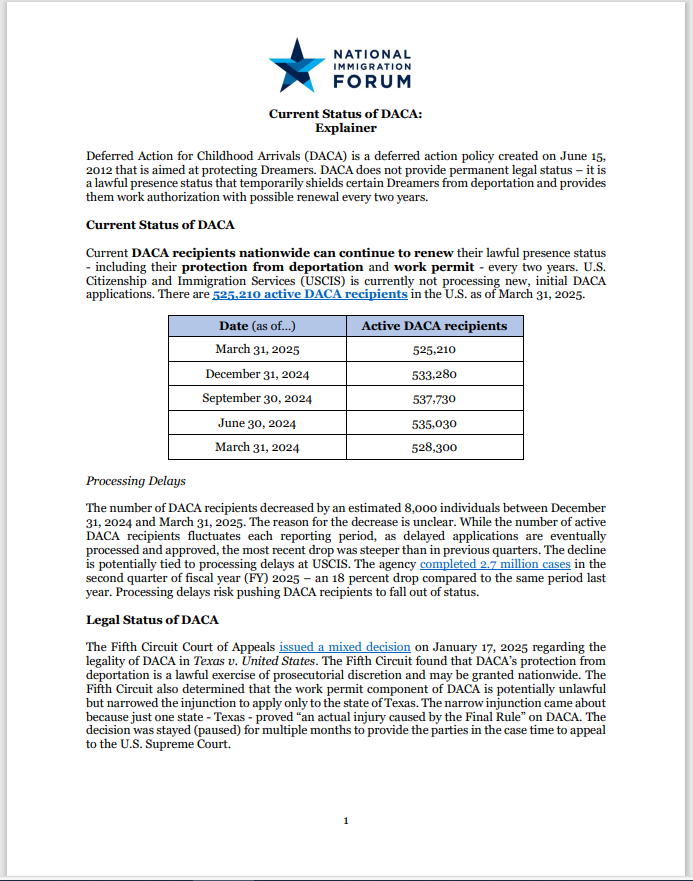
Deferred Action for Childhood Arrivals (DACA) is a deferred action policy created on June 15, 2012 that is aimed at protecting Dreamers. DACA does not provide permanent legal status – it is a lawful presence status that temporarily shields certain Dreamers from deportation and provides them work authorization with possible renewal every two years.
Current Status of DACA
Current DACA recipients nationwide can continue to renew their lawful presence status – including their protection from deportation and work permit – every two years. U.S. Citizenship and Immigration Services (USCIS) is currently not processing new, initial DACA applications. There are 525,210 active DACA recipients in the U.S. as of March 31, 2025.
| Date (as of…) | Active DACA Recipients |
| March 31, 2025 | 525,210 |
| December 31, 2024 | 533,280 |
| September 30, 2024 | 537,730 |
| June 30, 2024 | 535,030 |
| March 31, 2024 | 528,300 |
.
Processing Delays
The number of DACA recipients decreased by an estimated 8,000 individuals between December 31, 2024 and March 31, 2025. The reason for the decrease is unclear. While the number of active DACA recipients fluctuates each reporting period, as delayed applications are eventually processed and approved, the most recent drop was steeper than in previous quarters. The decline is potentially tied to processing delays at USCIS. The agency completed 2.7 million cases in the second quarter of fiscal year (FY) 2025 – an 18 percent drop compared to the same period last year. Processing delays risk pushing DACA recipients to fall out of status.
Legal Status of DACA
The Fifth Circuit Court of Appeals issued a mixed decision on January 17, 2025 regarding the legality of DACA in Texas v. United States. The Fifth Circuit found that DACA’s protection from deportation is a lawful exercise of prosecutorial discretion and may be granted nationwide. The Fifth Circuit also determined that the work permit component of DACA is potentially unlawful but narrowed the injunction to apply only to the state of Texas. The narrow injunction came about because just one state – Texas – proved “an actual injury caused by the Final Rule” on DACA. The decision was stayed (paused) for multiple months to provide the parties in the case time to appeal to the U.S. Supreme Court.
The Fifth Circuit’s decision moved toward implementation after none of the parties in the case sought an appeal to the Supreme Court by the May 20, 2025 extended deadline. The Fifth Circuit’s decision, if fully implemented, would likely establish the following system:
Fifth Circuit’s Decision
- Deferred Action. DACA’s protection from deportation would be allowed nationwide for current and (new) initial DACA recipients.
- Employment Authorization Documents (EADs). Access to work permits for DACA recipients would be allowed nationwide for current and (new) initial DACA recipients, with the possible exception of Texas.
- Initial DACA Applications. Dreamers who are eligible for DACA but do not currently have DACA could apply and be approved for the program. USCIS has not processed (new) initial DACA applications since October 2017 when litigation blocked new people from entering the program, permitting only renewals.
- DACA in Texas. DACA recipients in Texas (current and new) could access the program’s protection from deportation, but potentially not work permits.
The case is now back before U.S. District Court Judge Andrew Hanen of the Southern District of Texas, who must modify his original order to comply with the Fifth Circuit’s decision. Judge Hanen will determine how to implement the Fifth Circuit’s decision in Texas, in particular as it relates to work permits. DACA recipients in Texas could see a winding down of work authorization in the state.
Takeaway
The Fifth Circuit’s decision is in the process of going into effect. USCIS continues to accept, but is not processing, (new) initial DACA applications. Meanwhile, DACA recipients in Texas can continue to renew their status, including work permits, every two years. The next step is for Judge Hanen to issue a decision modifying his original order to comply with the Fifth Circuit’s decision.
Will USCIS process new DACA applications? What are the requirements?
Possibly. The Fifth Circuit decision allows USCIS to process new, initial DACA applications, but the agency may argue it is not required to process those new applications. The decision itself does not include explicit language requiring such an action.
To be eligible for DACA, young undocumented individuals would need to meet the program’s original requirements, which were first established in 2012 and are quite stringent:
- Came to the U.S. before age 16;
- Have resided continuously in the U.S. since June 15, 2007;
- Were present in the U.S. on June 15, 2012;
- Were under the age of 31 on June 15, 2012;
- Are currently in school, have graduated or obtained a GED certificate, or that they have been honorably discharged from the military; and,
- Have not been convicted of a felony, significant misdemeanor, or three or more misdemeanors, and do not otherwise pose a threat to national security or public safety.
When USCIS was accepting new applicants for DACA, applicants were required to be at least 15 years of age. New applicants have been largely unable to obtain DACA since 2017, when the first Trump administration and subsequent litigation blocked the processing of new applications. Many Dreamers were too young to apply for DACA (due to the requirement to be at least 15 years of age) before USCIS stopped processing new DACA applications in 2017.
What will happen to DACA in Texas?
One possible scenario is that DACA recipients in Texas will be able to apply for protection from deportation, but potentially not work permits. Current DACA recipients in Texas who have work authorization will likely continue to maintain that authorization until it expires, but not be able to renew it.
Presumably, DACA recipients in Texas could renew their work permits if they move out of Texas to another state. There are 87,890 DACA recipients in Texas – the second highest number in the country. Texas could see a mass exodus of DACA recipients from the state.
Judge Hanen has so far not taken any steps to wind down DACA in Texas. MALDEF, an intervenor in the case on behalf of 22 DACA recipients, stated that with respect to employment authorization in Texas they will be, “advocating for an extended period of implementation that is respectful, to the maximum extent possible, of the important reliance interests identified by the Supreme Court in its 2020 decision rejecting the first Trump administration’s rescission of DACA.”
Where do DACA recipients live?
As of March 31, 2025, there are DACA recipients in every U.S. state, Washington, D.C., and Puerto Rico.
| DACA Recipients by State of Residence | |||||
| # | State | DACA Recipients | # | State | DACA Recipients |
| 1 | California | 147,440 | 27 | Pennsylvania | 3,870 |
| 2 | Texas | 87,890 | 28 | Arkansas | 3,680 |
| 3 | Illinois | 27,800 | 29 | Alabama | 3,550 |
| 4 | Florida | 20,590 | 30 | Ohio | 3,410 |
| 5 | New York | 20,520 | 31 | Connecticut | 2,870 |
| 6 | North Carolina | 20,160 | 32 | Missouri | 2,590 |
| 7 | Arizona | 19,810 | 33 | Nebraska | 2,400 |
| 8 | Georgia | 17,290 | 34 | Kentucky | 2,270 |
| 9 | Washington | 13,330 | 35 | Idaho | 2,260 |
| 10 | New Jersey | 12,670 | 36 | Iowa | 2,050 |
| 11 | Colorado | 11,830 | 37 | Louisiana | 1,400 |
| 12 | Nevada | 10,290 | 38 | Mississippi | 1,130 |
| 13 | Oregon | 7,820 | 39 | Delaware | 1,110 |
| 14 | Virginia | 7,620 | 40 | Rhode Island | 720 |
| 15 | Indiana | 7,470 | 41 | Washington, D.C. | 470 |
| 16 | Utah | 6,960 | 42 | Wyoming | 410 |
| 17 | Maryland | 6,560 | 43 | Hawaii | 340 |
| 18 | Tennessee | 6,460 | 44 | New Hampshire | 220 |
| 19 | Wisconsin | 5,370 | 45 | South Dakota | 190 |
| 20 | Oklahoma | 5,160 | 46 | North Dakota | 130 |
| 21 | South Carolina | 4,990 | 47 | West Virginia | 120 |
| 22 | Michigan | 4,410 | 48 | Montana | 90 |
| 23 | New Mexico | 4,380 | 49 | Maine | 70 |
| 24 | Kansas | 4,350 | 50 | Alaska | 60 |
| 25 | Massachusetts | 4,300 | 51 | Puerto Rico | 50 |
| 26 | Minnesota | 4,220 | 52 | Vermont | 20 |
.
Demographics
Most DACA recipients are female (54 percent) and both the average and median age of a DACA recipient is 31, though most (37 percent) are between ages 26 to 30. Most are single (66 percent), but 31 percent are married. A smaller percentage is divorced (3 percent), and 690 DACA recipients are widowed. They have all lived in the U.S. since at least June 15, 2007, more than 18 years ago.
What is the solution?
Congress must pass a bipartisan, legislative solution to protect Dreamers, including DACA recipients, and provide them with permanent legal status.
DACA lacks long-term permanence. DACA recipients in Texas, and perhaps in the future in other states, run the risk of no longer being able to access work permits. This loss would have a deep, significant impact on the personal and economic well-being of DACA recipients, as well as their families, communities, and employers. Without access to work permits, DACA recipients will not be able to work legally in the U.S. and the country will not benefit from their skills and contributions.
The Trump administration may also decide to make another attempt to end DACA. The Trump administration attempted to end DACA in 2017. At the time, the administration did not use proper procedures or provide a well-reasoned explanation for its actions, which led to litigation that ultimately blocked the attempted end of DACA on procedural grounds. The administration may once again try to end DACA, this time through a more proper process.
Congress is the only body that can provide DACA recipients and other Dreamers, including DACA-eligible individuals, with an opportunity to stay in the U.S. Such legislation would cement the contributions of Dreamers in America.
.


